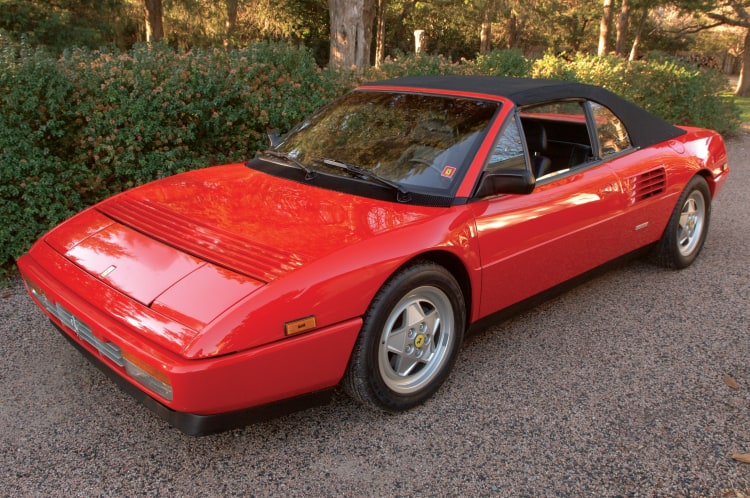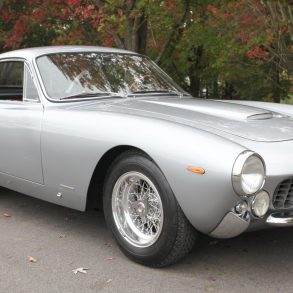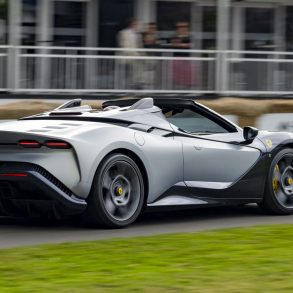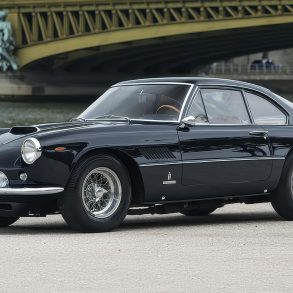The Ferrari Mondial is one of the most affordable Ferrari cars out there today. If you are planning on buying one, you are at the right place as we will take you through some of their common problems seen along with their current valuations.
Owning a Ferrari at least once is high on the list for all true Ferrari enthusiasts. The prime Italian sports cars have been in the focus of automotive enthusiasts for over 70 years, constantly introducing world-class performance cars that pushed the limits further.
Of course, such accomplished vehicles were never cheap with the prices of classic models like the Ferrari Testarossa rising.
However, what if we say to you that there is a way that you can experience classic Ferrari ownership for the price of a well-appointed mid-size family SUV?
The Ferrari Mondial is an affordable Ferrari with many great attributes. Featuring the styling by Pininfarina and bodywork by Carrozzeria Scaglietti, the Mondial is very comfortable, sounds great, and has loads of room in the back for the kids.

Despite these attractive features of this classic car, the Mondial has received criticism due to its disappointing performance. Regardless of this, having a car displaying the Ferrari badge is something achievable. Today we will provide some great tips you should be aware of when buying a Ferrari Mondial.
Background of Ferrari Mondial
The Ferrari Mondial was the last 2+2 V8 prancing horse produced by Maranello before the California arrived in 2008. It was unveiled at the 1980 Geneva Auto Salon and offered for sale later that year.
The new Italian sports car had modern styling, pop-up headlights, a low profile, and 2+2 seating configuration, making it a practical and daily usable model.
The Mondial was built on a modified Ferrari 308 platform with a mid-engine chassis and featured the same engine and components, although with more interior room and practicality.

The production of the Mondial commenced in 1980 and was discontinued in 1993, with several updates being implemented throughout its life cycle, being the Mondial 8, Quattrovalvole, 3.2, and T.
Mondial 8
The first variant was known as the Mondial 8 and was produced between 1980 to 1982, with a total of 703 vehicles constructed. Although this early Mondial was exclusively built as a coupe, the three succeeding iterations included Cabriolets.

With the 308 GT4 having limited room for passengers in the rear seats, its replacement, the Mondial 8, was 100mm longer, wider (35mm at front and 85mm at rear), and 40mm taller to provide a more spacious cockpit for the back seats.
Behind the passenger compartment, the well-known Ferrari Dino 308 GT4 3.0-liter V8 engine was transversally mounted and featured a modern K-Jetronic fuel injection system. Despite generating 214 horsepower at 6600rpm and 181 pound-feet of torque at 4600rpm, the Mondial 8 was considered slow and underpowered. It took 8.3 seconds to sprint to 60 mph and had a top speed of 143mph.
When the Mondial 8 was produced, only a five-speed manual was fitted, which remained standard until 1989 when the Mondial T also offered an automated manual.
Mondial Quattrovalvole
Due to criticism regarding sluggish speed, in 1982, the Mondial Quattrovalvole coupe was introduced, featuring a 4-valve per cylinder technology. The engine produced an increased output of 240 horsepower, which slightly improved the performance, sprinting to 60mph in 6.4 seconds.

Its appearance resembled the Mondial 8, though it featured red engine heads and a striking”Quattrovalvole” script at the rear.
The Mondial QV was available in both coupe and cabriolet (released in 1983), which attracted more buyers. Almost immediately, Mondial became one of the best-selling Ferrari models both in Europe and United States. In total 1,145 coupes (1982 – 1985) and 629 cabriolets (1983- 1985) were produced.
Mondial 3.2
The third iteration of the Mondial, unveiled at the Frankfurt Motor Show in September 1985, was the Mondial 3.2. It featured a slightly larger version of the existing V8, with its displacement rising to 3.2-liters and power increasing to 266 horsepower.

Styling was updated to include body-colored bumpers, a revised interior and from 1987, ABS was an option. Features added to enhance the driving experience included a quicker steering rack and the front track was widened by 25mm for better turn in.
In total 987 coupes were produced (1985-88) with 810 Cabriolet constructed.
Mondial T
The final and most powerful iteration was the Mondial ‘T’, which was introduced in 1989.

The Mondial T was equipped with an all-new 3.4-liter V8 that delivered an incredible 300 hp making this little Ferrari a seriously fast car, at least by the standards of the day.
The Mondial T had a longitudinally mounted engine and transverse gearbox, forming a ‘T’ shape layout, unlike the Mondial vehicles of previous years, which had both their engines and gearboxes mounted transversely. This enabled the engine to sit lower in the chassis which allowed for better handling.
Along with a revised engine, the Mondial T offered power steering, an anti-lock braking system, and for the first time on a production Ferrari, an electronically-controlled adjustable suspension.
Despite most vehicles being fitted with a 5 speed manual transmission, some featured a semi-automatic gearbox from the French company Valeo.
In total 840 coupes and 1,010 Mondial T cabriolet vehicles were produced between 1989 to 1993.
How much is a Ferrari Mondial Worth?
The Ferrari Mondial is one of the most affordable Ferrari vehicles to be purchased. Later versions that are faster and more powerful command a higher price. For instance, the average value for a Ferrari Mondial 8 is $23,500 whereas the average value for a Mondial T is $34,000.
When comparing the coupe to the cabriolet, the coupe will attract a higher price which can range from several hundred to several thousand dollars.
Each version price can be further determined depending on its condition. Below are some examples of the price range that can be found. These prices have been sourced from Hagerty and are as of May 2021.
1980 Ferrari Mondial 8 Valuation
| Condition | Price |
|---|---|
| Concours | $35,000 |
| Excellent | $28,000 |
| Good | $23,500 |
| Fair | $18,000 |
1984 Ferrari Mondial Quattrovalvole
| Condition | Price |
|---|---|
| Concours | $39,900 |
| Excellent | $31,100 |
| Good | $25,000 |
| Fair | $19,100 |
1992 Ferrari Mondial T Valuation
| Condition | Price |
|---|---|
| Concours | $51,100 |
| Excellent | $40,900 |
| Good | $34,000 |
| Fair | $25,800 |

Ferrari Mondial: Inspecting to Purchase
The Mondial may be cheap to buy, but the Ferrari shop rates and parts costs are expensive. This has unfortunately led to deferred maintenance by some owners, which has fostered neglect. Looking for a car that is serviced regularly can go a long way in reducing the chance of major problems occurring in the future.
Take your time to inspect the car during the day. Vehicles that may appear in great cosmetic appearance may be hiding expensive mechanical issues.
If you are looking at purchasing a Ferrari Mondial here are some areas that you should focus your attention when inspecting the vehicle.
Exterior of the Mondial
Almost all sports cars from this period have a deadly enemy in the form of corrosion, and the Mondial is no exception.

The most critical places to inspect are the wheel arches, underneath the sills, floors, bottom of the doors, and underneath the rubber strip below the rear window. Look for signs of re-painting or surface imperfections that may indicate body-filler beneath the paint.
Cabriolet Top Latches
While the Ferrari Mondial cabriolet is really the perfect way to enjoy the open-air driving and V8 soundtrack, we must warn you that roof latches are prone to breaking. Many owners have experienced this issue and replaced them, so don’t be alarmed if you see Mondial with different style roof latches than expected.
Engine
You have probably heard the horror stories about expensive Ferrari maintenance, and for the most part, they are true.
However, the Mondial vehicles are significantly cheaper to service since the Mondial engine doesn’t need to be pulled out of the car for replacing items like the timing belt or clutch. Though, in post-1989 models, the engine/transmission combo is required to be removed from the vehicle.
Every type of V8 engine installed in Mondial had its share of potential problems, and it is highly recommended you know what to look for in the specific version you are looking to buy.

As with any classic sports car, it is highly recommended to start the vehicle from cold and monitor the amount and color of exhaust fumes. The small amount of gray smoke is to be tolerated, especially during a cold start, but if you see black, oily, or even white smoke coming from the tailpipes, it means that the engine could be in dire need of an expensive rebuild.
Timing Belt
The timing belts for the Mondial require replacing every 30,000 miles or every three years. If the timing belt goes while driving it can potentially do some serious damage to your engine including to the camshaft, pistons and valves.
Enquire when the timing belt was last changed and confirm it has been done in an appropriate timeframe or mileage.
Suspension
Since the suspension setup on Mondial is very straightforward, you shouldn’t expect any problems in this area. However, the things you should pay attention to are tired dampers and suspension bushes that can intefere with the handling.
Tires
Inspect the condition of the tires. The Mondial used Michelin TRX metric tires until 1987, which are hard to find and quite expensive to replace.

Fuse box
The electrics are one aspect that Mondial owners can have trouble with, and this is an area that should be thoroughly checked. The problem with the fuse box is based on a multilayer circuit board that has the potential to delaminate over the years and cause multiple short circuits and electrical issues.
Interior
Seats
All Mondial interiors were fitted with leather. Examine the leather for wear as although localized damage can be repaired at a reasonable cost, a full retrim will be pricey.

Switches
Test all switches to confirm they are working. Switchgear can also be an issue with Mondial, and although they are unlikely to break, the inside can develop light surface corrosion, where they won’t function properly. The solution is to clean them thoroughly.
Sunroof Drive Cable
The Mondial with the sunroof is a desirable option but very problematic when it breaks. The most common failure is the drive cable which is known for snapping even after light use. The replacement parts are practically impossible to find, and we suggest keeping them closed at all times.
Slow Windows
The electric windows operate slowly on many Mondial vehicles which is a common problem.
Toolkit
Check to see that both tookits are present in the vehicle as they are expensive to replace.
Hope this guide helps you navigate a path to success in finding that perfect vehicle for you!










